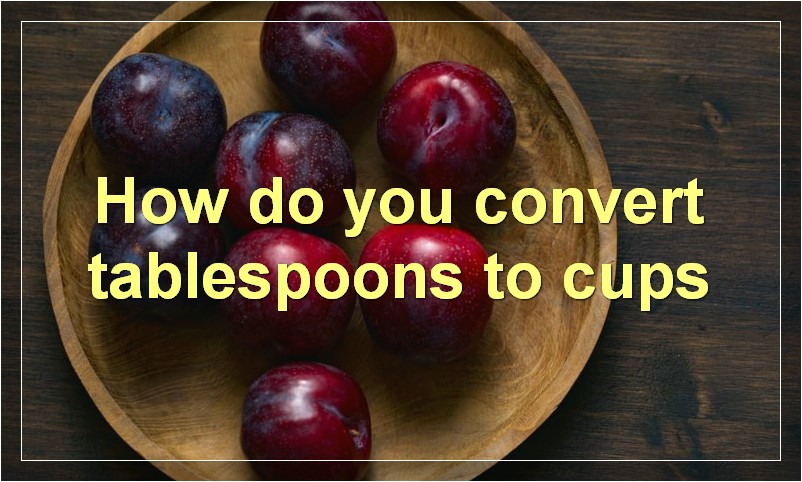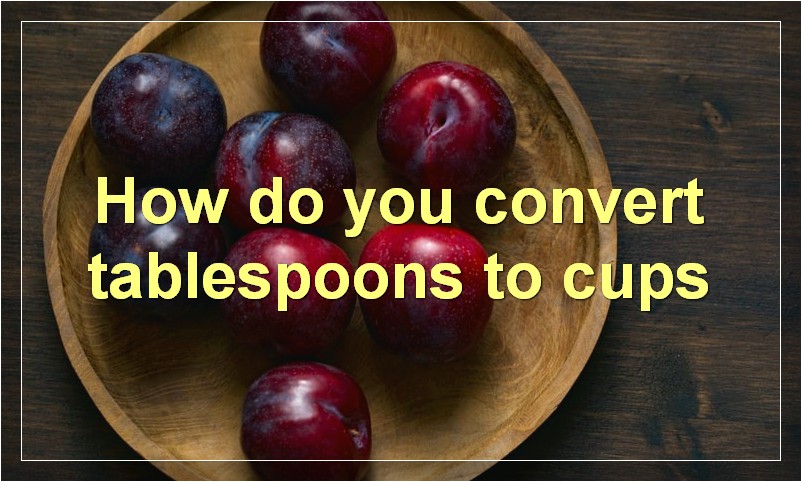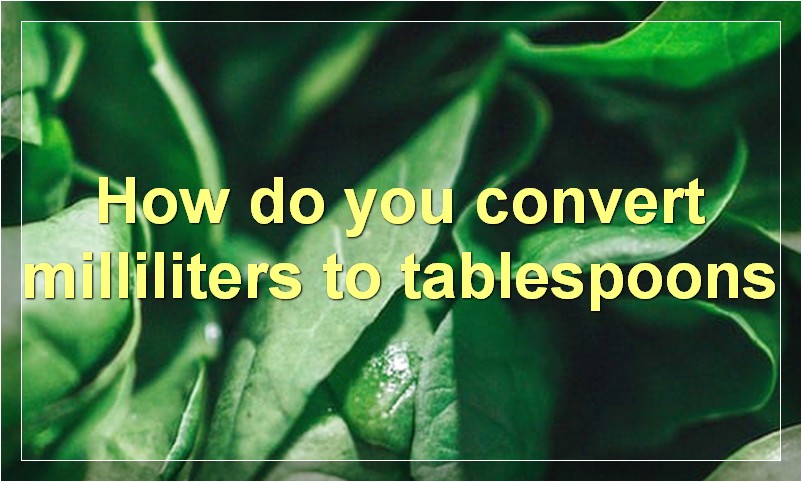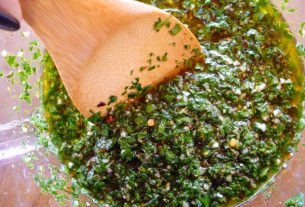If you cook, bake, or measure anything at all, it’s important to know how to convert between standard measurements for volume. Whether you’re working with teaspoons, tablespoons, cups, pints, quarts, or gallons, this guide will show you how to make the conversions you need.
How many tablespoons are in a cup
A cup is a unit of measurement typically used for liquid volume. Though its exact size varies by region, a United States customary cup holds 8 fluid ounces. In the metric system, a cup is equal to 250 milliliters. There are 16 tablespoons in a cup.
How do you convert tablespoons to cups

If you’re like most people, you probably don’t give much thought to how many tablespoons are in a cup. After all, these measurements are standard units of measurement that are used in recipes around the world. But if you’re working in the kitchen and you need to convert tablespoons to cups, it’s important to know how to do so.
One tablespoon is equivalent to 0.5 fluid ounces or three teaspoons. One cup is equivalent to 8 fluid ounces or 48 teaspoons. Therefore, there are 16 tablespoons in a cup.
If you need to convert tablespoons to cups, you can use this simple formula: 1 tablespoon = 0.0625 cups. So, if you have 2 tablespoons, that would be equivalent to 0.125 cups. And if you have 3 tablespoons, that would be equivalent to 0.1875 cups.
Now that you know how to convert tablespoons to cups, you can be sure that your recipes will turn out just the way you want them to!
How many teaspoons are in a tablespoon
There are 3 teaspoons in a tablespoon. This means that there are 48 teaspoons in a cup and 192 teaspoons in a quart.
How do you convert teaspoons to tablespoons
When it comes to cooking, measurements are everything. Too much of one ingredient can ruin a dish, while too little can make it bland. So, when a recipe calls for teaspoons and you only have tablespoons, or vice versa, how do you make the conversion?
Converting teaspoons to tablespoons is actually a pretty simple process. 1 tablespoon is equal to 3 teaspoons. So, if a recipe calls for 1 tablespoon of an ingredient, you can simply use 3 teaspoons of that ingredient instead.
Of course, this conversion isn’t always so cut and dry. When dealing with smaller amounts, such as converting 1/2 teaspoon to tablespoons, things can get a bit tricky. The best way to handle these types of conversions is to use a conversion chart.
There are a number of online conversion charts that can help you quickly and easily convert teaspoons to tablespoons (and vice versa). Simply type “teaspoons to tablespoons conversion chart” into your favorite search engine, and you’ll be sure to find what you’re looking for.
So, the next time you find yourself in a cooking predicament, don’t panic. Just remember that 1 tablespoon is equal to 3 teaspoons, and consult a conversion chart if need be. With these tools in your arsenal, you’ll be whipping up delicious dishes in no time!
How many milliliters are in a tablespoon
A tablespoon is a unit of measurement for volume. The most common way to measure a tablespoon is by using the metric system, which would be equivalent to 15 milliliters. There are other ways to measure a tablespoon, such as using the imperial system, which is equivalent to 20 milliliters.
How do you convert milliliters to tablespoons
When it comes to measuring ingredients, converting between units can be tricky. But whether you’re a beginner in the kitchen or a seasoned chef, it’s important to know how to convert milliliters (mL) to tablespoons (tbsp).
Here’s a quick and easy guide on how to convert mL to tbsp.
First, it’s important to understand the difference between the two units of measurement. A milliliter is a unit of volume, while a tablespoon is a unit of measurement. One tablespoon is equivalent to 3 teaspoons or 15 milliliters.
To convert mL to tbsp, divide the number of mL by 15. For example, if you have 30 mL of liquid, that would be equal to 2 tbsp.
If you don’t have a measuring spoon handy, there are other ways to estimate the conversion. For instance, 1 mL is approximately equal to 0.0336 fluid ounces (fl oz). So, if you have 30 mL of liquid, that would be approximately 1 fl oz, or 2 tbsp.
It’s also worth noting that the size of a tablespoon can vary depending on where you’re from. In the United States, a tablespoon is equal to 1/16 of a cup or 3 teaspoons, while in the UK, a tablespoon is equal to 1/20 of a cup or 4.7 milliliters.
So now that you know how to convert mL to tbsp, you can measure your ingredients with confidence!
How many fluid ounces are in a tablespoon
There are many different measurements of volume, but the most common unit of measurement for liquids is fluid ounces. One tablespoon is equivalent to three teaspoons or 0.5 fluid ounces. Therefore, there are two fluid ounces in a tablespoon.
How do you convert fluid ounces to tablespoons
There are several ways to convert fluid ounces to tablespoons, and the method you use will depend on whether you have a scale or not. If you have a scale, the easiest way to convert fluid ounces to tablespoons is by weight. There are 16 tablespoons in a cup, so you would simply need to weigh the liquid in ounces and divide by 16 to get the number of tablespoons.
If you don’t have a scale, you can still use the same method, but you’ll need to do a little more work. First, find an object that you know weighs one ounce. This could be a small piece of fruit, a poker chip, or even a paperclip. Once you have your object, fill a container with water until it is completely submerged. Remove your object from the water and mark the level of the water with a pen or pencil. Now empty out the container and refill it with water again, this time measuring carefully so that you add exactly the same amount of water as before. Add your object back into the container and mark the new water level. The difference between the two marks is the amount of fluid ounces that your object displaced. Since there are 16 tablespoons in a cup, divide the number of fluid ounces by 16 to get the number of tablespoons.
For example, let’s say you found a small rock that weighed one ounce. You would fill a container with water, submerge the rock, and mark the water level. Then you would empty out the container, refill it with exactly the same amount of water, and submerge the rock again. This time when you mark the water level, there will be a small gap between your two marks. This gap is equal to one fluid ounce. So if you divide that by 16, you’ll see that there are 0.0625 tablespoons in one fluid ounce.
Of course, if you’re working with larger amounts of liquid, it might be easier to use a conversion chart. Here’s a quick reference guide for converting fluid ounces to tablespoons:
1 fluid ounce = 2 tablespoons
2 fluid ounces = 4 tablespoons
3 fluid ounces = 6 tablespoons
4 fluid ounces = 8 tablespoons
5 fluid ounces = 10 tablespoons
6 fluid ounces = 12 tablespoons
7 fluid ounces = 14 tablespoons
8 fluid ounces = 16 tablespoons
9 fluid ounces = 18 tablespoons
10 fluid ounces = 20 tablespoons
What is the difference between a tablespoon and a cup
When it comes to measuring ingredients, tablespoons and cups are not created equal. A tablespoon is a smaller unit of measure than a cup, and thus you’ll use fewer tablespoons of an ingredient than you will cups. But what exactly is the difference between these two units of measurement?
A tablespoon is defined as a unit of measure that is 1/16th of a cup. This means that there are 16 tablespoons in a cup. When you’re measuring out ingredients with a tablespoon, you’re typically using a liquid measurement. That’s because it’s easier to pour liquids into a tablespoon than it is to scoop dry ingredients like flour.
A cup, on the other hand, is a larger unit of measure. There are 2 cups in a pint, 4 cups in a quart, and 8 cups in a half-gallon. When you’re measuring dry ingredients like flour or sugar, you’ll use cups rather than tablespoons. That’s because it’s easier to scoop dry ingredients into a cup than it is to pour them into a tablespoon.
So when you’re baking cookies and the recipe calls for 1/2 cup of sugar, you’ll need to use 8 tablespoons of sugar. And if the recipe calls for 1 tablespoon of flour, you’ll only need 1/16th of a cup of flour.
Now that you know the difference between these two units of measure, you can be sure to use the right one when cooking or baking. Just remember: tablespoons are for liquids and cups are for dry ingredients.
How do you measure a tablespoon
A tablespoon is a unit of measurement used in cooking. It is equivalent to 3 teaspoons or 1/16 of a cup. There are 2 measurements in a tablespoon, a level measurement and a heaped measurement. The difference between the two is that the level measurement is level with the top of the spoon while the heaped measurement is when the ingredient is mounded on top of the spoon.
When measuring dry ingredients, such as flour or sugar, it is best to use the dip and sweep method. This means that you dip the spoon into the ingredient and then level it off with a knife. For wet ingredients, such as milk or oil, you should use the pour method. This means that you hold the spoon over the measuring cup and pour the ingredient until it reaches the desired amount.
Tablespoons can be abbreviated as tbsp, tbls, or tbs. In recipes, an abbreviation is often used so that the reader knows how much of an ingredient is needed without having to look up the conversion. For example, if a recipe calls for 2 tablespoons of sugar, it can be abbreviated as 2 tbsp sugar.
Now that you know how to measure a tablespoon, put your new skills to the test with this delicious recipe for Chocolate Chip Cookies!




